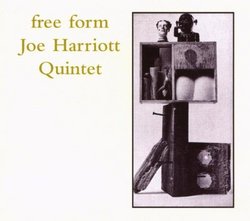Early Free Jazz from Overlooked Musician
directions | Space Time Foam | 05/16/2007
(5 out of 5 stars)
"I would buy this over "Abstract" until they reissue that as well as the sound on "Freeform" is digitally remastered. Other than that they are both classics. Joe Harriott was closer to Charlie Parker and Sonny Rollins than John Coltrane. However, he was not just imitating Ornette Coleman. He clearly had his own style. For a similar sounding recording a few years later, try "Our Man in Jazz" by Sonny Rollins (playing with Don Cherry and Billy Higgins from Ornette's classic line up) who also flirted with aspects of free jazz in the 60's. Thanks to a certain free jazz blog Destination-Out, Joe Harriott got the posthumous recognition he deserved and this album was reissued. Let's hope other unknown but classic free jazz artists get the same treatment."
Going mad in a quiet way; just listen to the music.
greg taylor | Portland, Oregon United States | 05/05/2007
(5 out of 5 stars)
"First the facts of the recording: this 1960 session features Joe Harriott on alto sax, Ellsworth "Shake" Keane on trumpet and flugelhorn, Pat Smythe on piano, Coleridge Goode on bass and Phil Seaman on drums. At the time of this recording, Harriott had recently undergone a convalescence for tubercluosis during which he reconceptualized his approach to music. Prior to that he had been a definite Charlie Parker disciple. By 1960, he was one of the first innovators of free jazz. Listening back to this music from the current scene it is hard to recognize it as early free jazz. There are definite themes and there seems to be a steady pulse. There is no real use of extended techniques (those really wouldn't become common in jazz for a few more years). It is free form in the sense that there is no set harmony. The melodic sense of the solo is less bluesy than, say, Ornette's. To me, the main attraction is the quality of Harriott's and Keane's soli- they both play with great passion and their interplay is outstanding (as on Calypso). The compositions are nice- there are sudden stops and melodic turns- it is easy to see why Charles Mingus was a fan.
My title is from Harriots own description of his music as "going mad in a quiet way". That is probably as apt a description as any.
In any case, don't let me description of this music as only being somewhat free jazz dissuade you. It is easy to look back from the vantage of almost fifty years and recognize that what seemed revolutionary at the time was merely a large step forward in the history of the music. Whenever I listen to Ornette's early recordings or to Trane with Dolphy at the Vanguard, I wonder what all the fuss was about (But then, I always did). What I want to emphasize is that this is pretty damn fine music that doesn't really need any historical significance attached to it. If you like early Ornette, mid-sixties McLean, or Ken McIntyre you will find a kindred spirit in Harriott's recordings. It is nice to see that new and sonically improved pressings of this CD are coming out. It is a chance for more of us to realize just how wonderful Mr. Harriott and his associates were.
p.s. If anyone can explain to me what the following means, please send me an email: 'Harriott was interested in how mode and interval, when stretched to their limits by extended harmonics, could create "impressions" of lyricism and melody, without actually engaging them.' I am particularly interested in how "extended" harmonics can stretch modes to their limits and thereby create impressions of lyricism. I would also like to know how extended harmonics have anything to do with Harriott's music."


 Track Listings (8) - Disc #1
Track Listings (8) - Disc #1